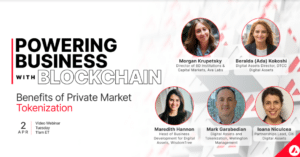

In February 2024 Citi said that it had successfully completed a proof of concept on tokenization of private funds along with Wellington Management and WisdomTree. Tokenization is the creation of a digital representation of physical assets such as real estate or financial securities or intangible assets such as identity or data, typically on a distributed ledger.
The proof of concept, which was conducted on the Avalanche Spruce institutional test Subnet, found that smart contract capabilities could deliver new functionality and operational efficiencies, which are currently unavailable with traditional assets. Smart contracts on a blockchain are programmable so that certain tasks are automatically executed when specified conditions are met, such as only allowing payment once assets have been delivered.
On April 2 Ava Labs, which developed smart contracts platform Avalanche, hosted a webinar – Powering Business with Blockchain: Benefits of Private Market Tokenization, to discuss how tokenization can benefit financial institutions.
Maredith Hannon, head of business development for digital assets at WisdomTree, said on the webinar that the asset manager views digital assets from two angles. The first is delivering crypto into the mainstream through a traditional finance wrapper, such as a bitcoin ETF, and also real world assets into the digital assets ecosystem.
Hannon said: “We are very excited about this proof of concept as it showcases a lot of the work that we are doing with institutions to help create efficiencies.”
Private markets
The proof of concept tested the tokenization of a private equity fund issued by Wellington by bringing it onto a distributed ledger, with ABN Amro simulating the role of a traditional investor.
Ioana Niculcea, partnerships lead at Citi Digital Assets, said on the webinar that the bank was very excited to collaborate in the proof of concept to preview how real world assets can be brought into the digital networks and begin to understand some of the potential workflow efficiencies.
“The proof of concept could also showcase new capabilities that could be enabled by the underlying digital infrastructure,” she added.
Niculcea said the test focussed on private markets because it is an asset class of more than $10 trillion asset, but has limited access, greater operational inefficiencies, lack of standardisation and transparency. There are also legal and regulatory requirements that need to be met around the characteristics of the investor, and this is the first area that the bank decided to address.
“We saw it as a template where we can learn and then apply a similar model to other asset classes,” Niculcea added.
Mark Garabedian, digital assets and tokenization at active manager Wellington Management, said private markets are expanding.
“More and more companies are choosing to stay private and the bulk of investment gains over the last decade were in private markets relative to public markets so there is a great opportunity,” he added.
However, there are a lot of barriers to entry, such as investment minimums in order to access a private fund.
Garabedian said: “The soapbox issue for me that we tackled within this proof of concept is democratising access and I think that is really powerful.”
Fractionalisation allows an investor to surmount the investment minimums for private funds, allows investors to move allocations more efficiently and gives them more robust portfolio capabilities according to Garabedian.
Smart contracts
Citi issued the smart contract that controlled the movement of the private fund token and Niculcea said the bank tested multiple transfer scenarios.
The bank evaluated parameters around compliance, investor requirements and distribution rules that could be embedded into a smart contract and enforced automatically at the fund unit or ownership level. The underlying fund distribution rules were encoded into the smart contract and embedded in the token transferred using simulated identity credentials issued by WisdomTree.
Hannon said: “I love this proof of concept, because it really showcases the power of smart contracts.”
She explained that there is a general assumption that smart contracts can only work on an “if then” basis. However many of the processes in traditional finance required to execute a trade through its lifecycle can be programmed in smart contracts.
In the proof of contact approximately 12 client attributes were programmed into the smart contract according Hannon. These included whether investors were US qualified or overseas and whether they qualified for capital calls.
“The proof of concept was an opportunity to push the envelope in terms of the art of the possible,” she added. “It showed a fund can move from a private chain to a public subnet, be sold to an underlying client, transferred to another client with regulatory compliance being maintained.”
Garabedian agreed that embedding compliance within an asset is one of the more powerful aspects of tokenization.
“Making analogue processes that could take weeks or months into instant atomic processes really breaks down the frictions which we can pass on as investment outperformance to our clients,” he added.
Collateral
The private fund token was also as collateral in the proof of concept using an automated lending contract with DTCC Digital Assets (formerly Securrency).
Beralda Kokoshi, digital assets director at DTCC Digital Assets, said that a few years ago the buy side saw blockchain and tokenization as concepts, but has moved to seeing potentially tangible solutions to problems.
“We are seeing an emergence of digital networks that crystallise in parallel to traditional networks,” she added.
DTCC, the US post-trade market infrastructure, aims to provide interconnectivity and portability across these analogue and digital systems and networks. The role of DTCC in the proof of concept was to take the token that had been traded into a lending smart contract and replicate processes such as a loan request, a deposit withdrawals, the delivery of collateral and its pricing.
“All those scenarios were tested in our workflows, based on the contracts that we had set up, and that was extremely powerful,” said Kokoshi.
She continued that if atomic settlement is translated into real capital markets operations, this will free up capital and enable more liquidity.
“This will be super beneficial if implemented at scale and something that we are truly excited about,” added Kokoshi.
DTCC completed its acquisition of Securrency, which developed institutional-grade, digital asset infrastructure in December last year. The business was rebranded as DTCC Digital Assets.
Kokoshi described the acquisition as “monumental” within the blockchain ecosystem because it was one of the first moves by a key US financial infrastructure to buy technology for tokenization. She added: “It showed the industry the seriousness for the next chapter of digital assets which provide much needed efficiency, scale and automation.”
DTCC has set up workflows around collateral management and lending of digital assets. Kokoshi said: “We will have more announcements coming about how different industry participants can test that workflow.”


